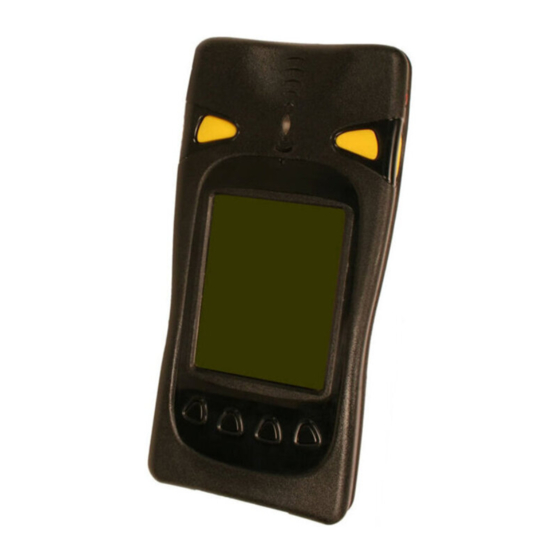Advertisement
Quick Links
ab
Safety and General Information
IMPORTANT INFORMATION ON SAFE AND EFFICIENT OPERATION.
READ THIS INFORMATION BEFORE USING YOUR HANDHELD DATA
TERMINAL.
RF Operational Characteristics
Your data terminal contains a radio frequency transmitter to convey the information
you wish to send as well as occasional automatic signals used to sustain connection
to the wireless network, and a receiver which enables you to receive communication
and connection information from the network.
For data radio terminals that have been approved as intrinsically safe, read the in-
structions and information on intrinsic safety in this booklet.
PORTABLE RADIO PRODUCT OPERATION AND EME EXPOSURE
Your Motorola radio product is designed to comply with the following national and
international standards and guidelines regarding exposure of human beings to radio
frequency electromagnetic energy (EME):
• United States Federal Communications Commission, Code of Federal Regula-
tions; 47CFR part 2 sub-part J
• American National Standards Institute (ANSI) / Institute of Electrical and Elec-
tronic Engineers (IEEE) C95. 1-1992
• Institute of Electrical and Electronic Engineers (IEEE) C95.1-1999 Edition
• International Commission on Non-Ionizing Radiation Protection (ICNIRP)
1998
Commercial, Government and Industrial Solutions Sector
1301 E. Algonquin Road, Schaumburg, IL 60196
Copyright © 2003 Motorola All Rights Reserved.
HANDHELD DATA
TERMINAL
HDT 600
6802965C93-B
@6802965C93@
July, 2003
• Ministry of Health (Canada) Safety Code 6. Limits of Human Exposure to
Radio frequency Electromagnetic Fields in the Frequency Range from 3 kHz
to 300 GHz, 1999
• Australian Communications Authority Radio communications (Electromagnetic
Radiation - Human Exposure) Standard 2003.
• ANATEL, Brasil Regulatory Authority, Resolution 256 (April 11, 2001) "addi-
tional requirements for SMR, cellular and PCS product certification."
To assure optimal radio product performance and make sure human exposure
to radio frequency electromagnetic energy is within the guidelines set forth in
the above standards, always adhere to the following procedures:
Body-worn operation
To maintain compliance with FCC RF exposure guidelines, if you wear a radio prod-
uct on your body when transmitting, always place the radio product in a Motorola
approved holster or carry case for this product. When placing your data ter-
minal in a carry case approved for body-worn applications for this device, it
must be inserted with the display facing away from the user's body. Use of
non-Motorola-approved accessories may exceed FCC RF exposure guidelines.
For additional information on RF exposure awareness information, visit the following
Motorola website: www.mot.com/rfhealth.
Electro Magnetic Interference/Compatibility
NOTE: Nearly every electronic device is susceptible to electromag-
netic interference (EMI) if inadequately shielded, designed or
otherwise configured for electromagnetic compatibility.
Facilities
To avoid electromagnetic interference and/or compatibility conflicts, turn off your ra-
dio data terminal in any facility where posted notices instruct you to do so. Hospitals
or health care facilities may be using equipment that is sensitive to external RF en-
ergy.
Aircraft
When instructed to do so, turn off your radio data terminal when on board an aircraft.
Any use of a radio data terminal must be in accordance with applicable regulations
per airline crew instructions.
Please retain for future use
Advertisement

Summary of Contents for Motorola HDT 600
- Page 1 IMPORTANT INFORMATION ON SAFE AND EFFICIENT OPERATION. To maintain compliance with FCC RF exposure guidelines, if you wear a radio prod- uct on your body when transmitting, always place the radio product in a Motorola READ THIS INFORMATION BEFORE USING YOUR HANDHELD DATA approved holster or carry case for this product.
- Page 2 Operational Warnings Medical Devices Pacemakers For Vehicles With an Air Bag The Advanced Medical Technology Association (AdvaMed) recommends that a Do not place a portable radio product in the area over the air bag minimum separation of 6 inches (15 centimeters) be maintained between a hand- or in the air bag deployment area.
- Page 3 Accessory Safety Information listed in the Accessories section of this manual. Other types of batter- ies may burst, causing personal injury and damage. IMPORTANT: SAVE THESE ACCESSORY SAFETY INSTRUCTIONS • Before using any battery or battery charger, read all the instructions for and cautionary markings on (1) the battery, (2) the battery charger, which may include a separate wall-mounted power supply or transformer, and (3) the radio product using the battery.
















